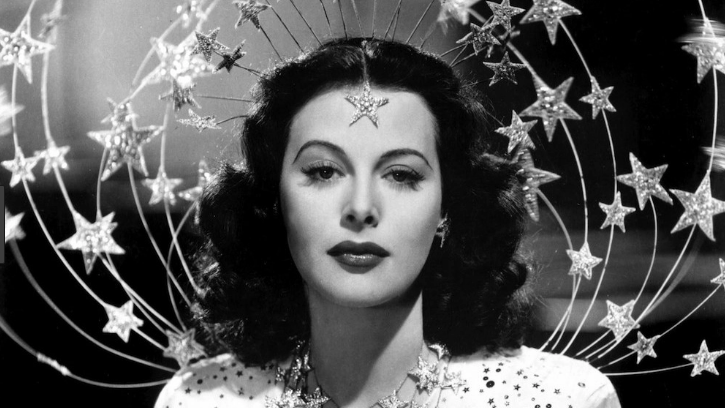Recognition, by Bob Connally
3 Jun
“The brains of people are more interesting than the looks, I think.” – Hedy Lamarr, 1990
One of the fascinating aspects of loving movies from Hollywood’s “Golden Age” is noticing how certain stars of the past are widely remembered today while others go largely forgotten, even if they were huge in their time. Even people who have never seen a Katherine Hepburn movie could probably tell you she was a popular actress of the 20th century. It’s likely they’ll have at least heard of Bringing Up Baby or Guess Who’s Coming to Dinner. Throughout the 1940s, Hedy Lamarr was considered by a great many people to be “the most beautiful woman in the world.” However, films such as Algiers, Boom Town, Ziegfeld Girl, and Dishonored Lady are really only known today by the most dedicated classic film aficionados. Lamarr herself is no longer widely known as a classic film star. But based on Alexandra Dean’s new documentary, Bombshell: The Hedy Lamarr Story, the Austrian woman born Hedwig Kiesler would probably be delighted to know that she is now remembered for something far bigger. Something for which she was denied recognition during her lifetime.
Dean’s film examines Hedy Lamarr’s complicated life and how the two paths she walked simultaneously- movie star and genius inventor- were both set from a young age. While still a teenager she could turn full rooms silent with her looks but from an even earlier age, Hedy’s fascination with how things worked sparked her intellectual curiosity. As a five-year old she took apart and reassembled her favorite music box to see its inner workings and to try to understand them.
At 16, Hedy decided to become an actress in her home city of Vienna. Within two years she had achieved global fame for a scene in 1933’s Ecstasy, which was considered lurid by the day’s standards. Not long after, the young Jewish film star fled Austria as well as her first stifling marriage and made her way to Hollywood, taking on the more glamorous sounding last name of Lamarr.
While her star soared in America and she put her inventive mind to use for then boyfriend Howard Hughes, the Second World War began to rage in Europe. When a German U-Boat torpedoed a ship full of British children in 1940, Hedy had an idea that would have ramifications for the world we live in today. “I got the idea for my invention,” she later wrote, “when I tried to think of some way to even the balance for the British. A radio-controlled torpedo I thought would do it.” The idea of sending secure transmissions through frequency hopping would be rejected at the time by the U.S. Navy but it would pave the way for the Wi-Fi technology you may be using to read this review.
Anyone telling the story of Hedy Lamarr could simply make the case that she was pigeonholed as a beautiful movie star and not taken seriously as an inventor not only for that reason, but also simply because she was a woman in the 20th century. While that was undeniably the case, Dean goes deeper to show how when society decides who someone is, it can be practically impossible to convince them that there can be anything more to them. For the rest of her days in the public eye, Hedy Lamarr was supposed to be the same twenty-something starlet that had arrived in the United States in the 1930s. For her to age the way normal people do was unacceptable and for her to be brilliant was a non-starter. As one of the interviewees in the film puts it, “You don’t get to be Hedy Lamarr and smart.”
In less than 90 minutes, Dean uses film clips, archival footage, and interviews with Lamarr’s children, biographers, lifelong fans such as Mel Brooks, and an unearthed 1990 interview with Lamarr herself to thoroughly examine the life of quite possibly the most fascinating person of the 20th century. It is the portrait of a life that had more than its share of sadness. In addition to her intellect being unrecognized throughout most of her life she became the subject of ridicule in her later years and she endured six loveless marriages. Still, she said that she had, “No regrets. You learn from everything all the time.” Thankfully near the end of her life she finally saw the beginnings of acceptance and recognition for her inventions.
18 years after her death, Hedy Lamarr’s story is still slowly becoming more and more commonly known. It is not her films or her iconic image that she is best known for today. It is not how she was the model for Snow White or the inspiration for Catwoman. It is how she changed the world for the better with her mind. For the “most beautiful woman in the world” there could be no greater legacy.
Bombshell: The Hedy Lamarr Story will be streaming on Netflix starting on May 31.




No comments yet